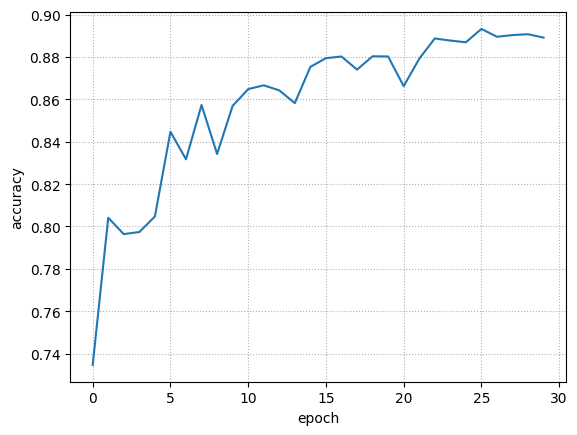实验五:全连接神经网络手写数字识别实验
【实验目的】
理解神经网络原理,掌握神经网络前向推理和后向传播方法;
掌握使用pytorch框架训练和推理全连接神经网络模型的编程实现方法。
【实验内容】
1.使用pytorch框架,设计一个全连接神经网络,实现Mnist手写数字字符集的训练与识别。
【实验报告要求】
修改神经网络结构,改变层数观察层数对训练和检测时间,准确度等参数的影响;
修改神经网络的学习率,观察对训练和检测效果的影响;
修改神经网络结构,增强或减少神经元的数量,观察对训练的检测效果的影响。
1 #构建一个类线性模型类,继承自nn.Module,nn.m中封装了许多方法 2 #本模型所用的包含库 3 import torch 4 import torch.nn as nn 5 import torch.nn.functional as F 6 import matplotlib.pyplot as plt 7 import torchvision 8 import numpy as np 9 import torch.optim as optim 10 from torch.utils.data import Dataset #这是一个抽象类,无法实例化 11 from torch.utils.data import DataLoader 12 from torchvision import transforms 13 from torchvision import datasets 14 import os 15 #构建一个compose类的实例,包含转tensor(张量),后面那个是标准化,两个参数分别是均值和标准差 16 train_transform = transforms.Compose([ 17 transforms.RandomAffine(degrees = 0,translate=(0.1, 0.1)),#对照片进行随机平移 18 transforms.RandomRotation((-10,10)), #随机旋转 19 transforms.ToTensor(), 20 transforms.Normalize((0.1307,),(0.3081,))]) 21 test_transform = transforms.Compose([transforms.ToTensor(), 22 transforms.Normalize((0.1307,),(0.3081,))]) 23 #这2个值也是调参重灾区…… 24 train_batch_size = 256 25 learning_rate = 0.006 26 test_batch_size = 100 27 random_seed = 2 # 随机种子,设置后可以得到稳定的随机数 28 torch.manual_seed(random_seed) 29 torch.cuda.manual_seed_all(random_seed) #为gpu提供随机数 30 # 下载训练集 MNIST 手写数字训练集 31 # 数据是datasets类型的 32 train_dataset = datasets.FashionMNIST( 33 root='../datasets', train=True, transform=transforms.ToTensor(), download=False) 34 35 test_dataset = datasets.FashionMNIST( 36 root='../datasets', train=False, transform=transforms.ToTensor(),download=False) 37 38 train_loader = DataLoader(dataset=train_dataset,batch_size=train_batch_size,shuffle=True,pin_memory=True) 39 test_loader = DataLoader(dataset=test_dataset,batch_size=test_batch_size,shuffle=False,pin_memory=True) 40 class Net(nn.Module): 41 def __init__(self): 42 super(Net, self).__init__() 43 #卷积层 44 self.conv1 = nn.Conv2d(1 ,32, kernel_size=5,padding=2) 45 self.conv2 = nn.Conv2d(32 ,64, kernel_size=5,padding=2) 46 self.conv3 = nn.Conv2d(64 ,128,kernel_size=5,padding=2) 47 self.conv4 = nn.Conv2d(128,192,kernel_size=5,padding=2) 48 49 #残差神经网络层,其中已经包含了relu 50 self.rblock1 = ResidualBlock(32) 51 self.rblock2 = ResidualBlock(64) 52 self.rblock3 = ResidualBlock(128) 53 self.rblock4 = ResidualBlock(192) 54 55 #BN层,归一化,使数据在进行Relu之前不会因为数据过大而导致网络性能的不稳定 56 self.bn1 = nn.BatchNorm2d(32) 57 self.bn2 = nn.BatchNorm2d(64) 58 self.bn3 = nn.BatchNorm2d(128) 59 self.bn4 = nn.BatchNorm2d(192) 60 61 #最大池化,一般最大池化效果都比平均池化好些 62 self.mp = nn.MaxPool2d(2) 63 64 #fully connectected全连接层 65 self.fc1 = nn.Linear(192*7*7, 256) # 线性 66 self.fc6 = nn.Linear(256, 10) # 线性 67 68 def forward(self, x): 69 in_size = x.size(0) 70 71 x = self.conv1(x) #channels:1-32 w*h:28*28 72 x = self.bn1(x) 73 x = F.relu(x) 74 x = self.rblock1(x) 75 76 x = self.conv2(x) #channels:32-64 w*h:28*28 77 x = F.relu(x) 78 x = self.bn2(x) 79 x = self.rblock2(x) 80 81 x = self.mp(x) #最大池化,channels:64-64 w*h:28*28->14*14 82 83 84 x = self.conv3(x) #channels:64-128 w*h:14*14 85 x = self.bn3(x) 86 x = F.relu(x) 87 x = self.rblock3(x) 88 89 x = self.conv4(x) #channels:128-192 w*h:14*14 90 x = self.bn4(x) 91 x = F.relu(x) 92 x = self.rblock4(x) 93 94 x = self.mp(x) #最大池化,channels:192-192 w*h:14*14->7*7 95 96 x = x.view(in_size, -1) #展开成向量 97 x = F.relu(self.fc1(x)) # 使用relu函数来激活 98 99 return self.fc6(x) 100 101 #调用GPU 102 os.environ["KMP_DUPLICATE_LIB_OK"] = "TRUE" 103 torch.backends.cudnn.benchmark = True #启用cudnn底层算法 104 device = torch.device("cuda" if torch.cuda.is_available() else "cpu") 105 #print(device) 106 torch.cuda.empty_cache() #释放显存 107 108 model.to(device) 109 110 # #构建损失函数 111 criterion = torch.nn.CrossEntropyLoss() #交叉熵 112 # 113 # #构建优化器,参数1:模型权重,参数二,learning rate 114 optimizer = optim.SGD(model.parameters(),lr=learning_rate,momentum=0.5) #带动量0.5 115 116 #optimizer = optim.RMSprop(model.parameters(),lr=learning_rate,alpha=0.99,momentum = 0.5) 117 # optimizer = torch.optim.Adam(model.parameters(), 118 # lr=0.05, 119 # betas=(0.9, 0.999), 120 # eps=1e-08, 121 # weight_decay=0, 122 # amsgrad=False) 123 #设置学习率梯度下降,如果连续2个epoch测试准确率没有上升,则降低学习率,系数0.5 124 scheduler = optim.lr_scheduler.ReduceLROnPlateau(optimizer, mode='max', factor=0.5, patience=2, verbose=True, threshold=0.00005, threshold_mode='rel', cooldown=0, min_lr=0, eps=1e-08) 125 #把训练封装成一个函数 126 def train(epoch): 127 running_loss =0.0 128 for batch_idx,data in enumerate(train_loader,0): 129 inputs,target = data 130 inputs,target = inputs.to(device),target.to(device) 131 optimizer.zero_grad() 132 133 #forward,backward,update 134 outputs = model(inputs) 135 loss = criterion(outputs,target) 136 loss.backward() 137 optimizer.step() 138 139 running_loss+=loss.item() 140 if batch_idx%300==299: 141 train_loss_val.append((running_loss/300)) 142 #print('[%d,%5d] loss:%3f'%(epoch+1,batch_idx+1,running_loss/300)) 143 print('[%d, %5d] loss: %.3f' % (epoch + 1, batch_idx + 1, running_loss / 300)) 144 running_loss = 0.0 145 #把测试封装成函数 146 def test(): 147 correct = 0 148 total = 0 149 with torch.no_grad(): 150 for data in test_loader: 151 images,labels = data 152 images, labels = images.to(device), labels.to(device) 153 outputs = model(images) 154 #torch.max()返回的是两个值,第一个是用_接受(蚌埠住了),第二个是pre 155 _, predicted = torch.max(outputs.data,dim=1) #从第一维度开始搜索 156 total += labels.size(0) 157 correct += (predicted==labels).sum().item() 158 print('Accuracy on test set: %f %% [%d/%d]' % (100 * correct / total, correct, total)) 159 160 return correct/total 161 train_epoch = [] 162 model_accuracy = [] 163 temp_acc = 0.0 164 train_loss_val = [] 165 for epoch in range(30): 166 train(epoch) 167 acc = test() 168 169 print(epoch + 1,acc) 170 train_epoch.append(epoch) 171 model_accuracy.append(acc) 172 scheduler.step(acc) 173 174 plt.figure(1) 175 plt.plot(train_epoch, model_accuracy) # 传入列表,plt类用来画图 176 plt.grid(linestyle=':') 177 plt.ylabel('accuracy') # 定义y坐标轴的名字 178 plt.xlabel('epoch') # 定义x坐标 179 plt.show() # 显示
1 Output exceeds the size limit. Open the full output data in a text editor 2 Accuracy on test set: 89.560000 % [8956/10000] 3 1 0.8956 4 Accuracy on test set: 89.340000 % [8934/10000] 5 2 0.8934 6 Accuracy on test set: 89.360000 % [8936/10000] 7 3 0.8936 8 Accuracy on test set: 89.380000 % [8938/10000] 9 4 0.8938 10 Epoch 4: reducing learning rate of group 0 to 3.0000e-03. 11 Accuracy on test set: 89.340000 % [8934/10000] 12 5 0.8934 13 Accuracy on test set: 89.470000 % [8947/10000] 14 6 0.8947 15 Accuracy on test set: 89.430000 % [8943/10000] 16 7 0.8943 17 Epoch 7: reducing learning rate of group 0 to 1.5000e-03. 18 Accuracy on test set: 89.360000 % [8936/10000] 19 8 0.8936 20 Accuracy on test set: 89.470000 % [8947/10000] 21 9 0.8947 22 Accuracy on test set: 89.440000 % [8944/10000] 23 10 0.8944 24 Epoch 10: reducing learning rate of group 0 to 7.5000e-04. 25 Accuracy on test set: 89.410000 % [8941/10000] 26 11 0.8941 27 ... 28 Accuracy on test set: 89.400000 % [8940/10000] 29 14 0.894 30 Accuracy on test set: 89.510000 % [8951/10000] 31 15 0.8951

修改神经网络的学习率,观察对训练和检测效果的影响;
在训练神经网络时,需要设置学习率(learning rate)控制参数的更新速度,学习速率设置过小,会极大降低收敛速度,增加训练时间;学习率太大,可能导致参数在最优解两侧来回振荡。学习率和训练次数同样也会影响正确率。学习率太高,代价函数不容易降低到最低点(会不断越过最低点)。
修改神经网络结构,增强或减少神经元的数量,观察对训练的检测效果的影响。
一般来说,在调参合理的情况下,层数和神经元数越多,正确率越高,不过相应地,容易出现过拟合






【推荐】国内首个AI IDE,深度理解中文开发场景,立即下载体验Trae
【推荐】编程新体验,更懂你的AI,立即体验豆包MarsCode编程助手
【推荐】抖音旗下AI助手豆包,你的智能百科全书,全免费不限次数
【推荐】轻量又高性能的 SSH 工具 IShell:AI 加持,快人一步
· 没有Manus邀请码?试试免邀请码的MGX或者开源的OpenManus吧
· 无需6万激活码!GitHub神秘组织3小时极速复刻Manus,手把手教你使用OpenManus搭建本
· C#/.NET/.NET Core优秀项目和框架2025年2月简报
· DeepSeek在M芯片Mac上本地化部署
· 葡萄城 AI 搜索升级:DeepSeek 加持,客户体验更智能